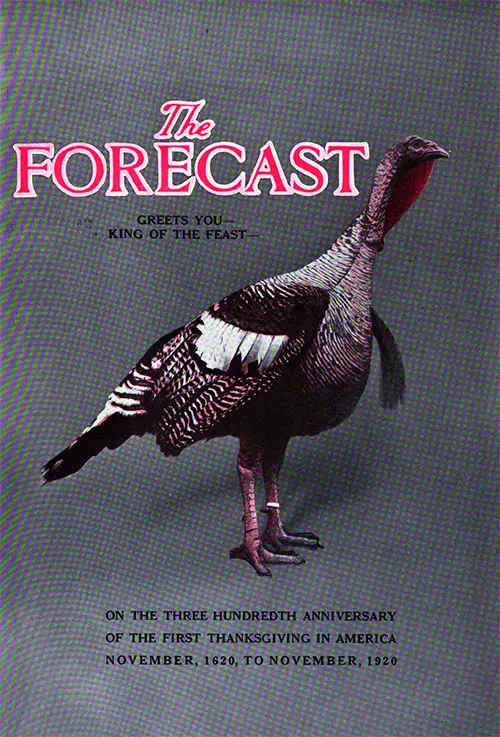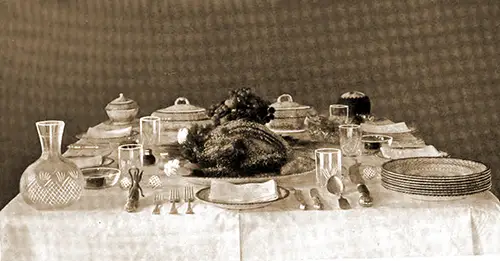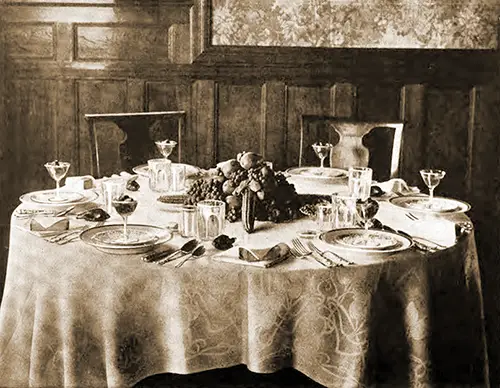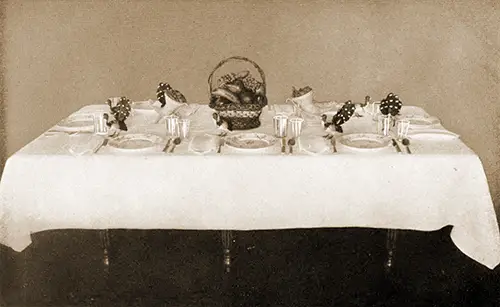Our 1920 Thanksgiving Feast

The Forecast Greets You, King of the Feast On the Three Hundredth Anniversary of the First Thanksgiving in America November 1620 to November 1920. Forecast Magazine, November 1920. GGA Image ID # 202b958c9b
This year's Thanksgiving feast should be a great day, a day celebrated in some happy fashion by every American citizen, for it commemorates the three-hundredth anniversary of the first Thanksgiving held by the Puritans to give thanks for a new home in a rich country that yielded them a bountiful harvest.
In 1920, we had many things for which to be thankful, just as our Puritan fathers had in 1620. Still, we cannot entirely agree with the prophetic wag of some years passed who added his predictions to Mother Shipton's that 1920 would be a year of plenty. Like most prophets, he missed his mark—perhaps he meant the coming year.
This year, the pinch from H. C. L. is felt by those who are not wealthy.

A Thanksgiving Table, Set Up for a Formal Meal. The Boston Cooking School Magazine, November 1901. GGA Image ID # 202c4047bb
The price of turkey is higher than it has ever been. We cannot enjoy cranberry sauce without thinking about the cost of sugar. Even raisins and nuts have soared skyward, and as to butter and cream for mashed potatoes, the thought makes us feel extravagant. Plum pudding and fruit cake are also almost prohibitive.
But we can still be thankful that we have not been driven to the predigested powder as a substitute for food. Such a prediction was made in the early part of the last century, the prophet proclaiming that those who might be living after the year 1900 would be toothless, having no need for teeth, as life would be sustained using powders and liquids; thus, saving much valuable time and trouble to the digestive apparatus. This prophet, too, missed his mark.
Most of us prefer taking the time required for eating, and we gladly accept stomach aches rather than give up the food we love, but we are all learning not to gormandize.
First of all, the cost of living will not permit us. Secondly, physical fitness is fast becoming the creed of our generation. A few years ago, most people thought having dinners of at least three or four courses was necessary. When it came to a feast day, like Thanksgiving, it was not uncommon to have five or six courses.
As a consequence, there was much sickness, and in some cases, people died from overeating. The modern man and woman are growing ashamed of weaknesses that lead to overeating as well as drinking. In the next few years, I feel sure that it will be looked upon almost as a disgrace for a man to overindulge his appetite for food.
Banquets are no longer held in honor of the dead, and neither do we celebrate to see how much meat we can stuff ourselves. We rarely find a modern Vitellus, living only to eat.
We eat now to live, but the wise man knows he lives better when he enjoys food. We no longer eat and drink like the old feudal barons until we lose our senses and fall beneath the table to sleep away our drunkenness and gluttony.
And indeed, there is no need for the philosopher raving about the good old folks of the good old days, for in controlling our appetites, we are certainly ahead of our long-ago ancestors and even of our fathers and mothers. We may not deserve the praise. Circumstances have forced us to be abstemious.
We do not have Indian friends in the forest to bring us gifts of venison. We cannot go to the woods and kill all the turkeys we might like eating. We are so busy working "the printing factory in Wall Street" or writing about what people ought or ought not to do that we have no time to raise pumpkins for pumpkin pie and let the sun kiss quantities of grapes that we have pulled, thereby making raisins for plum pudding.
All of these luxuries were found on the first Thanksgiving table when Governor Bradford invited the friendly Indians to feast with his Puritan followers, thereby founding the first Thanksgiving Day, which, by the way, lasted for three days of feasting and no doubt caused a cessation of active work for many days following, stomachs and livers rebelling against overwork.

Table Laid Out for a Formal Thanksgiving Dinner. The Boston Cooking-School Magazine, November 1913. GGA Image ID # 202c697c40
The first Thanksgiving, however, was not merely a feast. It was set apart as a Thanksgiving day because bountiful crops had been gathered, and the Puritans were happy in their new home. And that should be the real spirit of Nineteen-Twenty's Feast Day. It should be a day of rejoicing.
All pessimism should be thrown out of the window. Optimism should be raised within us to the nth power. We should try to make ourselves feel as content as the older man who said that he had been a widower for ten years; he was blind, deaf, and lame, but he was very grateful as he had two teeth, and they hit.
No one in the world has not something for which he should feel grateful. Thanksgiving Day is the time to examine ourselves and the world around us, seeking to find something suitable at all times.
Did you ever stop to think that there are many words in the English language standing for criticism but not one for virtue finding? There is good in everyone and everything if we only seek for it.
Why not make Thanksgiving our day, the one big day in the year to find the good in our fellow men and express gratitude for the joy of living? Let us not criticize but peroxidize (a word I have coined—meaning to see through).
When we see through anything, we will find the good. We need not deceive ourselves into believing there is nothing but joy on earth. We know that sorrow and suffering are the shadows that cause the brightness to be even brighter.
We can face the solemn truth that this is a challenging year, and perhaps we cannot afford a turkey, but why be sad? If not the turkey, a chicken will taste just as good if adequately cooked.
And if our pocketbooks will not permit the chicken, let us find another substitute. I know one clever mother who made a delicious nut roast out of Brazil nuts, celery, and bread-crumbs but served the roast as a turkey, molding it into the shape of a Thanksgiving Bird so that it delighted the eyes of her children as well as tickled their palates.
The American housewife can also learn from her French sister that "it is not so much what we eat as how we eat food and how the food appears in one's eyes."
No matter how busy a housewife is, she should beautify the Thanksgiving table and ornament it in some way suggestive of the first Thanksgiving held on American soil.
Unique paper tablecloths with designs appropriate to Thanksgiving can be purchased for no more money than having a white linen cloth laundered.
The children will be delighted to see a tablecloth decorated with fine-looking turkeys, and they will be pleased to have napkins bearing the same designs.
Ordinary dishes can be made tempting in appearance by a little extra garnishing or the happy placing of bright-colored stewed fruits and jams upon a white or cream custard foundation.
Plain cabbage coleslaw can be given the holiday air by placing it in a nest of green lettuce and ornamenting it with some pimento slices. If steak is served instead of turkey, it can be made even as tempting in appearance by placing a border of mashed potatoes and pea timbales around it.
A roast of pork or ham capped and surrounded by baked apples looks most tempting. Potatoes may be served in many unique ways, and cranberry jelly may be made in different forms as surprises to the children and ornaments to the table.

Thanksgiving Dinner Table Spread. Almost Ready for our Dining Guests. Catering for Special Occasions, 1911. GGA Image ID # 202c6d37c3
The 1920 good housewife thinks of gratitude for all her blessings and strives to "pervidize" in thinking about her neighbors. She also learns how to economize by going to market.
She does not use the telephone to order supplies for the Thanksgiving feast or confine herself to one stand in the marketplace. The wise woman goes from stand to stand to learn prices.
Good marketers always find better values by personal shopping. Some grocery stores specialize in certain foods to draw customers or have ample supplies. They can afford to sell a little cheaper to get rid of surplus stock.
The woman who makes a study of the market just as a stockbroker does of his stock market saves money and wins for her satisfaction.
And the housewife should also be a wise caterer, providing her family with foods that are not at war with each other. She should see that the palates are tickled on a joyous feast day but that there are proper mixtures of fats, carbohydrates, and proteins so that no excess of one will cause disturbances that require the help of a doctor.
For generations past, in the so-called good old days, a feast day meant a sick day to follow. Still, the kiddies and older folks were so fond of feasting that they were willing to take castor oil on Friday if they could feast to their fill on Thursday.
That was a rotten old custom in the days gone by that we hope will never return. Gluttons are no longer the fashion, and the castor oil remedy is repugnant to the intelligent.
But in the good or bad old days (call them as we will), there was a good old custom to think of the poor on Thanksgiving. And the word poor does not always stand for the person in the slums, the person who calls himself poor and begs for dinner.
That person will not be forgotten; those who can aid the Salvation Army in giving dinners to people experiencing poverty should do so cheerfully. But the poor and proud need cheer on Thanksgiving Day, even more than the so-called pauper.
The struggling artist in his cold studio and the poor young girl striving to make her living in a big city that affords her only a tiny cold bedroom and cheap restaurant food would rejoice to sit down to an authentic Thanksgiving dinner.
Think of what an artistically set table surrounded by happy faces would mean to one of these "live-alone." There is no use to chase after happiness. Feasts or amusements of any kind cannot catch it. It is right inside you, and it burns merrily when you make someone else feel its warmth.
Although 1920 may not stand for plenty in each home, let those of us blessed with homes and families show Thanksgiving for the love that is ours by inviting a "live-alone" guest on Thanksgiving Day.
Wrenn, Marjorie, "Our Nineteen-Twenty Thanksgiving Feast", in The Forecast: A Magazine of Home Effeciency, Vol. XX, No. 5, November 1920, p. 305, 338.
